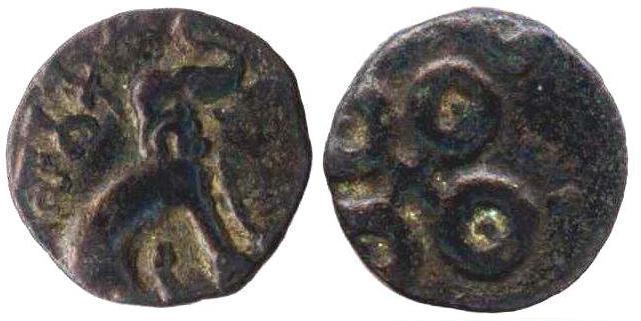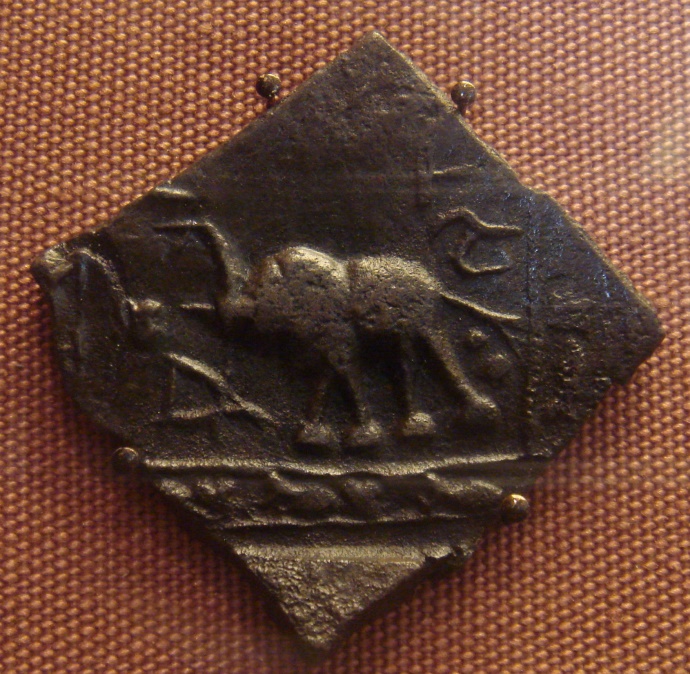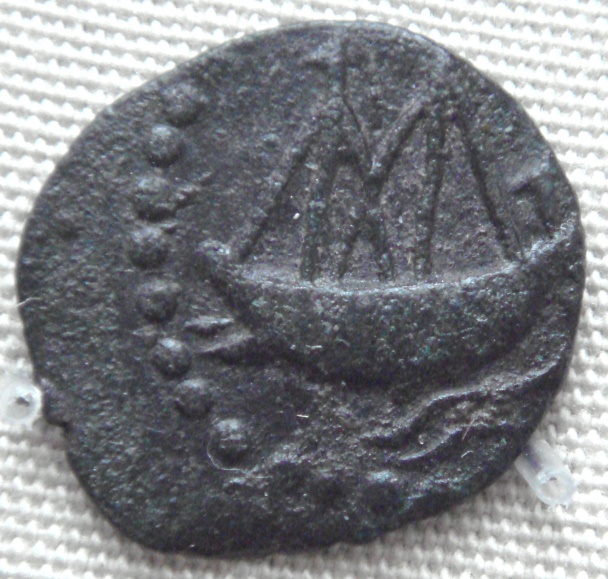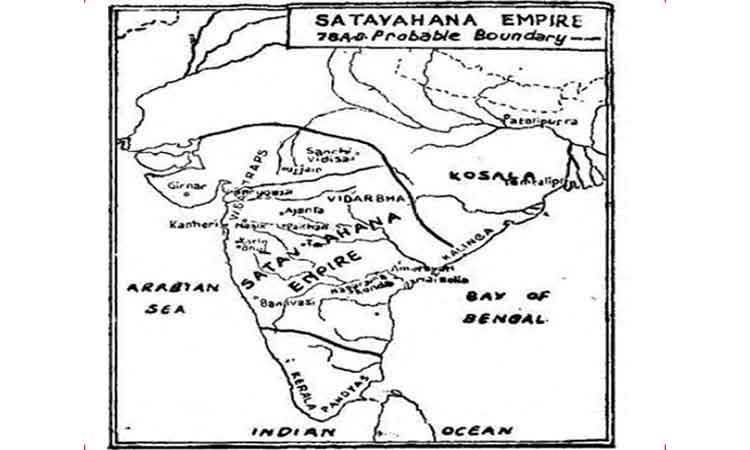Satavahana Empire - Political History of Satavahanas
- In History & Culture
- 07:51 AM, Sep 08, 2015
- Ramana Muppalla
Background: In the previous article an introduction to an empire called Satavahana Empire that ruled vast areas of India for more than 400 years that geographically stretched from current day portions of Sindh on the west to Orissa on the east and Madhya Pradesh on the north to Tamil Nadu in the South. The article is here: https://myind.net/satavahana-empire-largest-stable-indian-empire-ruled-most-india
In this article the political history of Satavahanas will be presented. In subsequent articles, administrative and cultural aspects of Satavahanas will be focused.
As it is written in the first part, it should be noted that History is always destroyed by the later invaders so that the indigenous revivalism becomes difficult. In that context remember the following from previous article -
“Unfortunately in India, any empire other than little bit of Mauryan or Gupta empires from pre Islamic time period does not find traction in school text books or regular narratives. The entire glories are either localized (very unfortunate) or made to be mysterious mythical folklore stories as opposed to official history. In case of Satavahana empire, in spite of reach of entire Bharat for a substantial longest period, the colonizers and writer have relegated it to some glorious empire but one that owned by Andhras from dakshin. The historians forget that evolution of multiple languages, cultural diversification happened much later than these empires. This kind of regionalization of great past in the mold of post-Islamic and colonial modern history blinds the unity and cultural commonality of India.”
The unfortunate thing about these glorious stable kingdoms is that even the names of the kings have been ascertained after a thorough research by the researchers. The reason for that can be attributed to destruction of history and evidence during Abrahamic religious era. The Islamic invasions and later European (French, Dutch, Portuguese and British) invasions did destruction of a lot of artifacts and historical evidences of indigenous cultures and rule. This destruction can be attributed to justify the foreign rule and later newer theories such as Aryan-Dravidian divide, fiction based Aryan invasion theories.
Political History of Satavahanas
Based on the timeline of this Empire (271 BC to 174AD), the Indian subcontinent religion wise it was still an era of pre-Abrahamic religions (Islam, Christian and Judaism). For the Indian subcontinent the influence of Buddhism has spread extensively and co-existed with Vedic religion (later known as Hinduism). In addition, this is an empire that followed another glorious empire called Mauryan Empire. By that time the Greek invasions and intermittent rule has occurred. In essence the Indian subcontinent has significant exposure to European cultures. The Central Asian culture of that time is not significantly different from that of the Indian culture of that era.
There are no available maps of Satavahana Empire with time periods and how it grew and exactly when it grew. However the 74AD Map and the chronology of emperors are presented in the previous article for reference.
Simuka Satavahana was the founder of the Satavahana Empire. He had not founded an independent state. He was the first to bring several Andhra region family groups united and to oblige them to recognize him as their mutual and unique leader. He emerged as a prominent figure about 271 B.C. When the great Asoka Maurya, was waging a bitter war of succession against his brothers, with Asoka's show of force in the Kalinga war, Simuka and his associates who held power for 23 years were content with their semi-independent status.
Kanha (Krishna), the brother and successor of Simuka due to influence of Ashoka’s dharma constructed a cave at Nasik for the Sramanas. Due the weakening of Ashoka and instability in Magadha, Kanha broke off from the Mauryan friendship and acquired an independent status for the area under his authority. In summary, Simuka is the founder but Satavahanas as an independent state from Mauryas has started under his Kanha (Krishna).
The earliest Satavahana ruler to receive wide recognition was Satakami-ll (184 B.C.—128 B.C.) who is the sixth king. The wide recognition was due to his policy of military expansion in all directions. He defied Kharavela of Kalinga. He was the 'lord of Pratishthana' (modem Paithan in the north-western Deccan. He conquered eastern Malwa (current Central India) which was being threatened by the Sakas (Scythians) and the Yavanas (Greeks). He gained control of the region of Sanchi (current day Madhya Pradesh). After conquering the Godavari valley, Satakami became the Dakshinapathapati (means lord of south). He supported the Vedic order and performed an Aswamedha to establish his claim to an empire.
The Satavahanas hold on the western Deccan was not stable. They were gradually pushed out of the west by the Sakas (Western Khatrapas). This is the era when the kings changed their coins as soon as they rule over. Kshaharata Nahapana's coins are found in the Nasik area. The Western Kshatrapas controlled this region by the first century A.D. By becoming master of wide regions including Malwa, Southern Gujarat, and Northern Konkan, from Broach to Sopara and the Nasik and Poona districts, Nahapana rose from the status of a mere Kshatrapa in the year 41 (58 A.D.) to that of Mahakshatrapa in the year 46 (63 A.D.).
Gautamiputra Satakami, the 23rd king of the Satavahanas, was one of the most illustrious rulers of ancient India. His ruled between 62 A.D. and 86 A.D. Some scholars attribute to him the foundation of the Salivahana era in 78 A.D. It should be noted that even today the New Year day Ugadi (Telugu and Kannada) Gudi Padva (Maharashtrian), Cheti Chand (Sindhi) and other celebrate based on this Salivahana saka calendar.
The credit goes to Gautamiputra as far the restoration of the fallen prestige of the dynasty is concerned. His accomplishments and achievements are found on the Nasik inscription of his mother Gautami Bala Sri and his own records at Nasik and Karte. His phenomenal success realized his ambition to recover the imperial position of the Satavahanas. He first won back the territories on his western borders from the Kshaharata successors of Nahapana. After his victory Nahapana's coins were struck in his name. Bala Sri's record credits him with the extirpation of the Kshaharata family. It is very clear for the archeological evidence that he humbled the power and pride of the Kshatriyas and destroyed the Yavanas (Greeks), Sakas (Scythians) and Pahlavas (Pahlavas are Indo-Parthian rulers who were a group of ancient kings from Central Asia).

Early Satakarni issue, Maharashtra – Vidarbha type

Satavahana 1st century BCE coin inscribed in Brahmi: "(Sataka) Nisa" - British Museum
The map with possible boundary of Satavahanas in 74AD:
Gautamiputra Satakarni's vast kingdom includes provinces of Asika, Asaka, Mulaka, Surashtra, Kakura, Aparanta, Anupa, Vidarbha, Akara and Avanti, the mountainous regions of Virtdhya, Achavata, and Pariyatra. Sahya, Kanhagiri, Siritana, Malaya, Mahendra, Seta and Chokora and extended as far as the season either side. These details indicate the extent of his empire over the country between Rajasthan and Cuddalore and between the Rishikulya (Orissa) and Vaijayanti (Karnataka). The legend tells that Gautamiputra made his horses drink the waters of the three seas. He was uniquely skilled as an archer, absolute as a sovereign and described as hero in folklore.
Though a successful king and warrior, Gautamiputra was excellent administrator and a father to his people. He fulfilled the duties of the Trivarga-Dharma, Artha and Kama. He shared the sorrows and pleasures of his people. He is described as 'the abode of the Vedas'.
Gautamiputra's son and successor Vasisthiputra Pulomavi (86-114 A.D.) could not maintain for long his hold over his vast inheritance. During the last years of his rule, he lost the north-western provinces of the Satavahana Empire to Chashtana, the founder of the Western Kshatrapa Kardamaka line. His successors, Siva Sri and Sivaskanda each ruled for seven years during which period the house of Chashtana expanded its authority up to Kutch in the west by 130 A.D. Chashtana's grandson Rudradaman is the biggest contributor to Kardamaka power.
Gautamiputra Yajna Sri (128 A.D. - 157 A.D.) was the last of the great Satavahana rulers. He made attempts to recover the western (Aparanta) provinces but did not succeed. Rudradaman won over the disgruntled Vasisthiputra Satakami, a relation of Yajna Sri, to his side by giving him his daughter in marriage. The two wars between Yajna Sri and Rudradaman's forces went against the Satavahanas. The Sakas stabilized their kingdom on the west. The Satavahana rule was confined to the current day Andhra area. The rule of Yajna Sri's successors, Vijaya, Chanda Sri and Pulomavi (III), is together a period of seventeen years, and are of little significance historically. Chutus in the west and south, the Abhiras in the Nasik area, the Ikshvakus in the east and the relentless pressure of the Kardamakas of Ujjain sounded the death of the Satavahana Empire. Thus came to an end the glorious phase of the rule of the Satavahanas who not only gave vast areas of Bharat a political integrity but protected it from foreign invaders (Greeks, Scythians, Iranians and central Asians) who inundated the North at that time.

Indian ship on lead coin of Vasisthiputra Sri Pulamavi, testimony to the naval, seafaring and trading capabilities of the Satavahanas during the 1st–2nd century CE
The Satavahana - Western Kshtrapa Relations
During the four and half centuries’ rule of Satavahanas, as they got in contact with neighboring kingdoms, their prominent engagement was with Western Kshatrapas. During the Indo-Parthian rule, the Satraps (Governors) were appointed to rule over various areas conquered by them. The prominent were Malwa and Saurashtra. The Kshatrapa rule includes that of the Kshaharatas like Bhumaka and Nahapana and of the Kardanraka family from Chashtana onwards. Bhumaka was the first ruler and the coins of Bhumaka mention him as a Kshaharata Kshatrapa and the symbol on them is of the Lion-capital. Mostly he ruled the areas of Gujarat. The figure of the thunder-bolt appearing on Nahapana's coins resembles that of the Mathura Kshatrapas. It is also known that some of the inscriptions of the Mathura Kshatrapas were incised on a lion capital. This proves that the Kshatrapa Kshaharatas were originally subordinates of the Mathura Kshatrapas. They declared themselves independent after the death of the great Mathura Kshatrapa Rajula in 17 A.D.
Nahapana succeeded Bhumaka on the western Kshatrapa throne and he expanded. Ushavadata, the son-in-law of Nahapana gifted places like Govardhana, Sopara, Dasapura, Prabhasa and Pushkara. Nahapano's inscriptions were discovered at Nasik, Karle and Junnar. These taken together show that in the north Nahapana's empire extended up to Rajasthan and in the south to Maharashtra. During 60 AD, Nahapana was having maximum grip in this area. Nahapana kingdom did the trade activity of Western India with the Red Sea ports, which was grabbed by Nahapana after defeating the Satavahana rivals Sundara Satakarni and Chakora Satakami. During his time, the Satavahana ports like Kalyan and Sopara lost their commercial importance to Barygaza.
Later Satavahanas under Gautamiputra Satakarni ended Nahapana's rule. After the destruction of Kshaharata power Gautamiputra Satakarni restored of the fortunes of the Satavahana family. Gautamiputra Satakarni achieved complete overhaul of the Kshaharatas and the Sakas, Yavanas and the Pahlavas. The Scytho-Parthians who ruled until the establishment of Kushana power effectively in northern India also tried to rescue of the Kshaharatas who were definitely defeated by Gautamiputra. In effect, Gautamiputra had wars with Kushanas to defend his expanding empire.
In addition to the achievements recorded by Gautamiputra he also granted the lands to the Buddhist monks, which were in possession of Ushavadata earlier. The erstwhile Kshaharata possession went into the hands of Gautamiputra by his 18th year in his rule. The list of areas Gautamiputra annexed from Kshaharata are Saurashtra, Aparanta, Malwa and parts of Rajasthan. After this victory, he restruck the coins of Nahapana as is known from the Jogelthambi hoard of coins.
Gautamiputra retained all these areas during his life time. He died around 87 A.D. and was succeeded by his son Vasisthiputra Pulomavi. The latter ruled for 28 years, i.e. from 87 A.O. to 115 A.D. Till his 19th year, the areas of rule under Gautamiputra have been retained by Pulomavi who is also called as 'Dakshinapatheswara'. During the last 9 years of rule, Pulomavi lost the Malwa region to Chashtana, the founder of the Kardamaka line. The Kardamakas were at first subordinates to the Kushanas before they became independent.
Chashtana of Ujjain is contemporary of Pulomavi of Satavahanas who was ruling at Paithan. Chashtana annexed some of the Satavahana areas between 106 A.D. and 114 A.D. The clashes between the Kardamakas and Satavahanas continued during the rule of Siva Sri and Siva Skanda on one side and Chashtana and Jayadaman on the other. During these conflicts Jayadaman died who predeceased his father Chashtana. The latter obtained the territory in between Malwa and Kutch including Saurashtra by about 130 A.D and thus came the portions Kardamaka Empire.
During 129 A.D., Yajna Sri Satakarni came to the Satavahana throne. His rule is limited due to the power of Rudradaman (grandson of Chashtana) who came to the throne in or after 130 A.D. Per the Girnar inscription of Rudradaman, corresponding to 150 A.D., the king is said to have defeated the 'Dakshinapathapati' Satakarni and liberated because of his non-remote relationship. This ruler could have been Yajna Sri Satakarni. The Aparanta region seems to have been the arena of conflict between the two empires and the defeat of Satavahanas in this conflict ended with the Aparanta territory becoming a Kshatrapa possession. After Yajna Sri rule, the rulers of the Satavahana family could not regain these areas and had to be contended with parts of the Andhra area.
There had been conflicts throughout between the Satavahanas and the Western Kshatrapas. One of the rebel-Satavahanas Vasisthiputra Satakarni trying to succeed Pulomavi clashed with the other Satavahana rulers for succession to the throne. He had entered into a matrimonial alliance with the Rudradaman’s daughter of Kshatrapas. As a benefit the Aparanta region went into the hands of Vasisthiputra Satakarni with the consent of his father-in-law Rudradaman.
Thus during the first and second centuries A.D., Western India was with Kshaharatas, later with the Satavahanas and lastly with the Kardamakas. There had been throughout a conflict between the Satavahanas and the Western Kshatrapas. The areas that were conquered by Rudradaman to a large extent are retained by his successors. The Satavahanas confined themselves to the Andhra region for nearly a quarter of a century more when their power finally ended in the hands of Ikshvakus.
Next part of this Satavahana Empire series will cover the details of Economy, trade, social, religion, wars and administration during the 400 years of Satavahanas.
By Ramana Muppalla







Comments